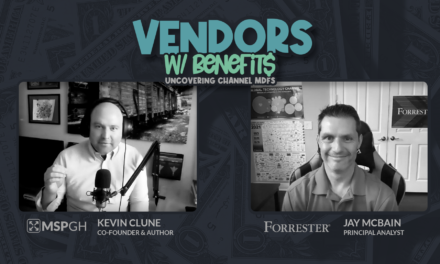Episode 05: Cheap Marketing
In this episode, Host Kevin Clune discusses how to close the financial gap between the “all or nothing” approach to marketing that plagues Managed Service Providers and offers insight into how to inexpensively take back control of your campaigns.
Subscribe to our YouTube Channel for more episodes of “The Lean MSP.”
Our Favorite Marketing Tools
Are you looking to improve your marketing capabilities? The right tools make all the difference. We compiled some of our favorite tools in our toolbox that we use to spin up eye-catching content.
Introduction
Kevin: “In this episode, I want to talk about cheap marketing. I wrote an article recently to help MSPs that wanted to get started with creating content. It made really think about the costly barriers that we put in front ourselves sometimes that really don’t need to be there. If I had plunger that could magically unclog thoughts from someone’s brain, I would use it to help MSPs understand that when it comes to marketing, quality and price are not the same thing.
I think what we need to remember is that the value of creativity is completely subjective. Someone in Miami recently paid $120,000 for a banana duct taped to a wall. Granted, it was the most perfectly ripe banana I have ever seen, but then again, I am from the northeast. We have two colors of bananas, green and brown.
The other thing that is worth noting here is that the material cost of digital marketing is essentially nothing. Not even the cost of a banana. So where do the costs come from when we pay for marketing? I will tell you. These costs come from labor, tools, templates, and distribution. So I’m going to take you through these 4 things very quickly and figure out how to form the right strategy to lower your investment on each one.”
Labor
Kevin: “The first is labor. One of the things that I have seen change the most in the last decade is that the half-life of a piece of content is drastically declining. There was a time when all you needed was a new brochure and that piece of content could drive your sales and marketing for an entire year. This is very far from the case right now. If you are successful and you build an audience, you are basically stuck on the hamster wheel to keep producing content to sustain that engagement.
Circling this back to labor, if you are producing content every week, then using an agency or expensive designer to do this is not going to be feasible unless you have a large budget (which you shouldn’t). In my opinion, the best way to go about this right now, is to produce content internally in as little time as possible and just put it out.
It may not look as good as your competitor who uses some slick marketing agency or has an in house designer, but your cost will be a fraction. And whether it cost you $25 or $2500, it is still going to get buried in people’s newsfeed all the same and possibly ignored for no apparent reason whatsoever. We are all subject to failure when it comes to content no matter how long we take to produce it. This is why perfection really has no place in this type of strategy. “
Tools
Kevin: “Now onto tools. If you are going to take the DIY approach, then much like home repairs, the right tools will make all the difference. To me this is one of the most frustrating things, primarily because there are a ton of great tools out there that I want to use, but they are all subscription based and it would be ridiculous to have them all.
I am going to post some links along with this episode to tools that I use or are popular choices, but ultimately you want to find ways to create attractive looking content that requires very little design skills. This way, all you have to do is add your substance to it, your expertise and messaging and then rely on these drag and drop graphic design systems, or video builders to polish it off for you.
Being a good designer is much like being a good chef. The more confident you are and the more refined your technique, the fewer ingredients you will use. The right tools can help you accelerate this process because they limit the use of certain aspect ratios, margins, and fonts that make a huge difference in your design.
For example, the recommended size of a video for instagram is different from youtube. In order to make your content look agency quality, it starts with getting these details right and these tools can do this for you. The most important thing here is that there are a ton of these out there. If you find one difficult to use or you dont like the result, stop using it and find a different one. Also, if you are subscribed to tools that you aren’t using, cancel them. You can always resubscribe later if you need to use it. “
Templates
Kevin: “As for templates. This is a necessary evil when it comes to marketing. Using a template for say a landing page, an ebook, or even a promotional video is a huge shortcut and can save you a ton of time or labor costs. In fact, many agencies or designers use these themselves as jumping off points even when you not know it. What I would like differentiate here is using a design template vs using a content template.
Design templates are basically just pre-designed pieces of content that you plug your own messaging and branding into that with enough editing become completely unique to you. Many of the tools we talked about earlier are really just design templates in a SaaS type format.
As for content templates, this is when you take someone else’s content and then brand it to yourself as if it were yours. You put your logo on it, maybe customize the colors and that is it. Unfortunately, there is a lot this available to MSPs either free from their vendors, or being offered as a service from someone else.
To me, this is not a great investment, primarily because even if it works and the content performs well, you are entirely reliant on someone else to keep producing more for you. Your competitors can also see what is working for you and then just go grab the same thing themselves. Autonomy is incredibly important in marketing and developing these skills in house will help your business grow in ways that you probably can’t foresee in the moment. If you want to market your business consistently without the stop and go that is common for MSPs.”
Distribution
Kevin: “Now on to Distribution. You can spend an infinite amount of money on distributing your content after you produce it. Whether this is paid to Facebook, Google, LinkedIn, it is all the same. I always get the question of how much should I budget for my campaign? My canned answer leaves many regretting they even asked because it’s the most obvious answer I could possibly give and makes me look like either a genius or an idiot depending on who you ask. You should spend as much money as possible on the campaigns that perform well and you should spend as little as possible, or nothing, on the campaigns that don’t.
So how do you create campaigns that perform well? I try to always manipulate my bidding strategy to beat the platform’s minimum cost per click. If I can do this then I know that I am getting the utmost value that the platform has to offer when it comes to accessing my target audience. For example, if the minimum Cost Per Click allowed is $5, then I want to bid on impressions and attempt to generate clicks for well beneath that. The way I do that is by refining my audience to be as narrow as possible and get the highest click through rate that I can for that piece of content.
If you were to tell a marketing vendor that you had a budget of $25 per day, they would probably tell you good luck. But in reality, that $25 per day when spent correctly, can generate thousands of impressions of your brand and 40-50 clicks to your content. What I find is that there is this large gap between MSPs that spend nothing on marketing and then MSPs that spend thousands of dollars. It doesn’t have to be this way.
With the right tools, tactics, and a little bit of time you can execute great marketing in house for very little money. Don’t let anyone tell you otherwise. That’s all for episode 05. Thanks for listening, and I hope you have a great week.”

SPONSORED BY ZEST














